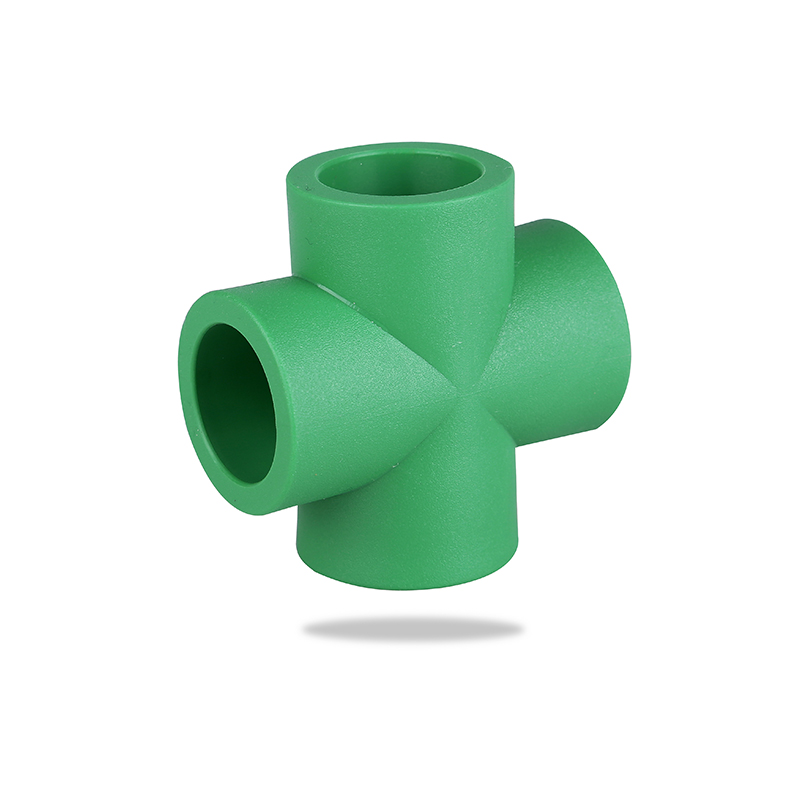The production process of PPR (Polypropylene Random Copolymer) crosses involves several critical steps that ensure consistent quality and reliability. PPR crosses are crucial components in plumbing and piping systems, and maintaining their quality is essential for preventing leaks, ensuring durability, and providing reliable performance over time. Here’s an overview of how the production process ensures these qualities:
Material Selection: The quality of PPR crosses begins with the selection of high-grade Polypropylene Random Copolymer (PPR) resin. This resin should have the appropriate molecular structure and melt flow index to provide the desired mechanical properties, such as high impact resistance, flexibility, and chemical resistance.Additives and Stabilizers: To enhance the performance of PPR crosses, the raw material may be mixed with additives like UV stabilizers, antioxidants, and colorants. These additives help prevent degradation from UV exposure, thermal oxidation, and other environmental factors, ensuring consistent quality and longevity.
Injection Molding: PPR crosses are typically produced using the injection molding process, which is highly precise and capable of producing complex shapes with tight tolerances. The process involves heating the PPR resin to a molten state and then injecting it into a mold cavity designed in the shape of the cross fitting.Controlled Molding Conditions: Key parameters such as temperature, pressure, and cooling time are carefully controlled during injection molding to ensure consistent wall thickness, smooth surfaces, and uniform material distribution. Proper control of these parameters minimizes defects like warping, shrinkage, or internal stresses that could compromise the fitting's quality.Automated Systems: Modern injection molding machines often use automated systems that maintain consistent conditions throughout the production run. Automation helps reduce human error and ensures each batch meets the same high standards.

Precision Mold Design: The design and quality of the mold play a crucial role in producing PPR crosses with consistent dimensions and properties. Molds are manufactured with high precision, ensuring that each cross fitting has the same shape, size, and wall thickness.Regular Mold Maintenance: Molds undergo regular inspection and maintenance to prevent defects like burrs, flash, or misalignment.Proper mold care ensures that the surface finish of the fittings remains smooth and free of imperfections, which is critical for reliable sealing and joint integrity.
In-Process Quality Control (IPQC): During production, quality control checks are performed at various stages to monitor the consistency of the PPR crosses. These checks may include visual inspections, dimensional measurements, and weight checks to ensure compliance with specifications.Hydrostatic Pressure Testing: After molding, PPR crosses are subjected to hydrostatic pressure testing to ensure they can withstand the rated pressure without leaking or failing. This test simulates real-world conditions and helps identify any weak points or defects.Impact Resistance and Flexural Strength Tests: PPR crosses are tested for impact resistance and flexural strength to ensure they can withstand mechanical stress and pressure changes. These tests help guarantee that the fittings will perform reliably in various applications.
Thermal Cycling Tests: PPR crosses may undergo thermal cycling tests, where they are repeatedly exposed to extreme temperatures to assess their resistance to thermal expansion and contraction. This ensures that the fittings do not crack or deform under temperature fluctuations.Stress Cracking Resistance: The resistance of PPR material to environmental stress cracking is tested to ensure it remains intact under varying loads and environmental conditions.Computer-Aided Design (CAD) and Computer-Aided Manufacturing (CAM): CAD and CAM technologies are used to design molds and optimize the production process. This ensures that the fittings are manufactured with high precision, reducing variability and defects.Robotic Automation and Consistent Process Control: Robotic automation and real-time process monitoring ensure consistent production quality. Automated systems adjust parameters like injection speed, pressure, and cooling time to maintain uniformity and prevent defects.
The production process of PPR crosses involves careful selection of high-quality raw materials, precision injection molding, stringent quality control, and advanced manufacturing technologies. By adhering to these processes and standards, manufacturers ensure that PPR crosses are reliable, durable, and consistent in quality, meeting the needs of various plumbing and piping applications.

 简体中文
简体中文 English
English русский
русский Español
Español Français
Français عربى
عربى Português
Português 日本語
日本語 italiano
italiano Nederlands
Nederlands Polskie
Polskie












